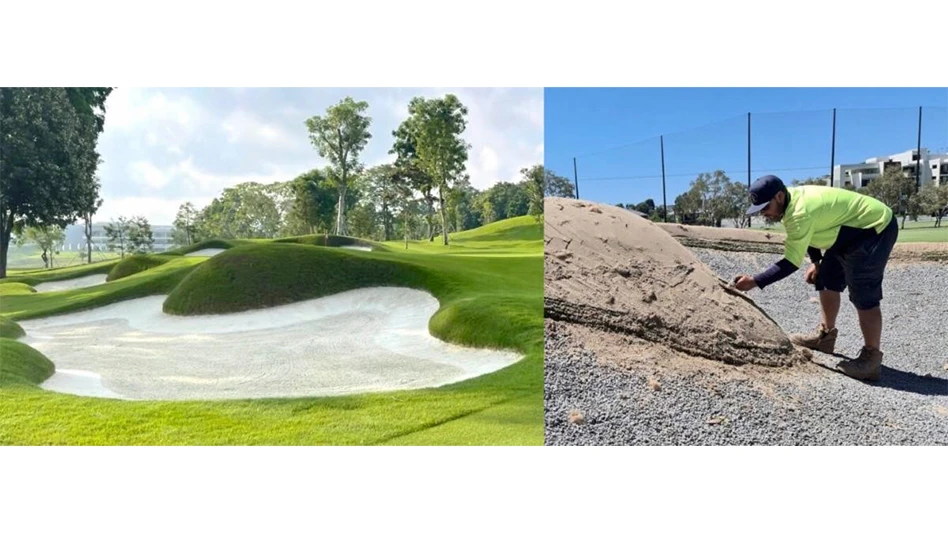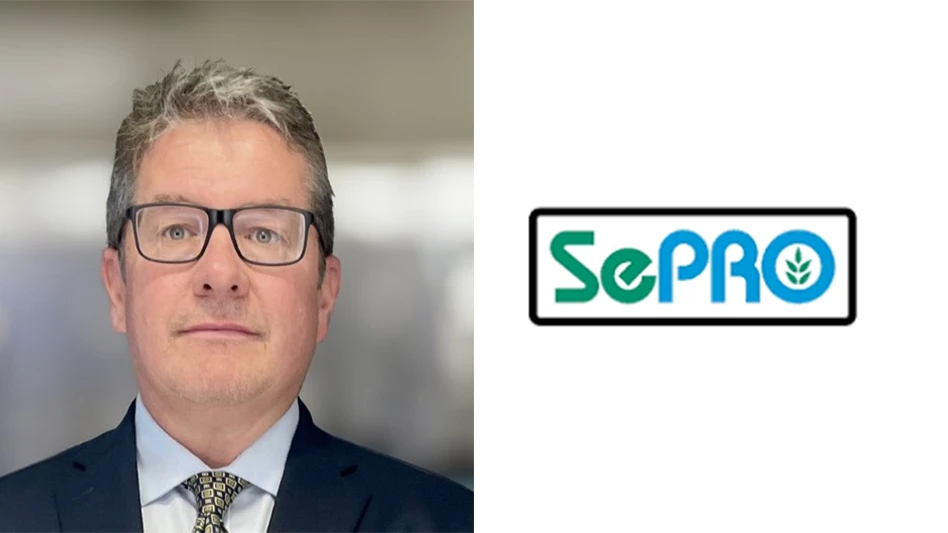
Courtesy of Loksand
LOKSAND Global has announced North American availability of the stabilization product LOKSAND, in addition to a new rep office in Jupiter, Florida, to support the business.
LOKSAND Global President Danny Potter — a former superintendent and founder of Centaur, one of the largest distributors of golf products in Asia-Pacific — also announced the LOKSAND’s first U.S. installation at Miakka Golf Club, an original Fry-Straka design taking shape 30 minutes east of Sarasota.
LOKSAND is a soil amendment featuring interlocking, crimped fibers that bind and stabilize soil and sand profiles, especially those supporting steep bunker faces in heavy rainfall regions.
Deployment of the LOKSAND soil amendment also allows superintendents, contractors and architects to tackle the problem of poor turf quality in heavily trafficked areas. According to Potter, LOKSAND protects and strengthens fairway cart-path entry and exit points, walkways and green exits — without resorting to repair or hardscape options.
“We can honestly build nearly anything with LOKSAND,” Potter said. “We’re still establishing the limits of what it can do. We’ve used it to build stunning vertical bunker faces 3-feet high. It perfectly stabilizes the steep noses of bunkers that dive into bunkers. Whether it’s a rolled-over edge, high verticals or slopes where golfers enter and exit bunkers, LOKSAND and its binding abilities keep everything in place without compromising percolation in any way. What’s more, LOKSAND can be mixed using whatever soils and sands you have on site. No need for any expensive import of particular sand mixes.”
LOKSAND has been vetted by course architects, contractors and superintendents in Australia and across the Asia-Pacific region. It’s now available in North America from the firm’s new Jupiter office.
“We believe in this product enough to distribute here ourselves,” said Potter, who founded his international distributor business after 20 years working as head superintendent at Khao Keow Country Club in Thailand, Laguna Bintan Gof Club in Indonesia and multiple courses at the Mission Hills Resort in southern China.
“It’s the crimp in the fiber that make the difference,” Potter added. “The crimp is what zigzags through the soil/sand particles and holds them all together. By adding the fibers, we're able to safely build bunkers with steeper angles of repose, in more dramatic shapes, without collapsing. The addition of LOKSAND also provides those faces better, more stable and predictable drainage and percolation, which invariably leads to better root structures — which ultimately stabilizes these steep areas that much better, over time.”
The LOKSAND technology first proved itself — to Potter and course clients — in one of the wettest environments on Earth: equatorial Southeast Asia. During his 2023 renovation at Singapore Island Country Club, architect Graham Marsh grew frustrated with constant erosion damage to the bunkers under reconstruction. Shapers would prepare new bunkers that, according to Potter, “were pretty gnarly, with quite high faces.”
Every time Marsh returned to check on construction progress, many had invariably eroded and collapsed.
“I’ve worked with Danny for years and told him we needed a solution,” Marsh said. “I could tell immediately that this stuff was holding. The bunker face was accepting it and the sand was staying in place. After several days of heavy rains — and nowhere in the world does it rain like Singapore — it remained in place. For me, LOKSAND is a sort of missing link in creating the perfect environment in which to build a bunker. It’s a big deal for the golf industry if you can build something so steep that will last.”
Added Potter: “There are many different ways to build a bunker, obviously, many different styles. LOKSAND is the license to build anything.”
That’s the storyline at Miakka GC, where Fry/Straka Global Golf Design and the owner made the decision to design and build North America’s first authentic Australian Sandbelt-style bunkers, complete with anywhere between 4 and 40 inches of exposed LOKSAND-amended soil separating the sand face from the turf profile.
The LOKSAND technology, for use in construction, was only hit upon in 2019. Potter freely admits that superintendents, contractors and architects are still determining what exactly LOKSAND can do. Clients in the sports field sector, for example, first discovered its ability to reinforce and improve damaged turf in high-traffic areas. Golf clients in Asia first hit upon LOKSAND’s utility in creating and maintaining waste areas.
“A lot of architects these days are looking for that natural look, native scrub areas that may or may not transition into a sand bunker,” Potter said. “Any course builder will tell you it’s difficult to get the stability you need in those native areas. Sands will move and migrate without an enormous amount of vegetation, which presents its own playability and maintenance issues. That unsecured environment also tends to shift; golfers are continually walking through it, up and down — the way golfers get in and out of bunkers.
“What we're able to do with LOKSAND is stabilize those native areas during construction. You’d never know it or see it: They still look completely natural. And you don’t need to over landscape those areas because the shapes created — and the sand supporting those shapes — aren’t going anywhere.”
Get curated news on YOUR industry.
Enter your email to receive our newsletters.Latest from Golf Course Industry
- Kerns featured in Envu root diseases webinar
- Toro continues support of National Mayor’s Challenge for Water Conservation
- A different kind of long distance
- Golf Construction Conversations: Stephen Hope
- EnP welcomes new sales manager
- DLF opening centers in Oregon, Ontario
- Buffalo Turbine unveils battery-powered debris blower
- Beyond the Page 66: Keep looking up






